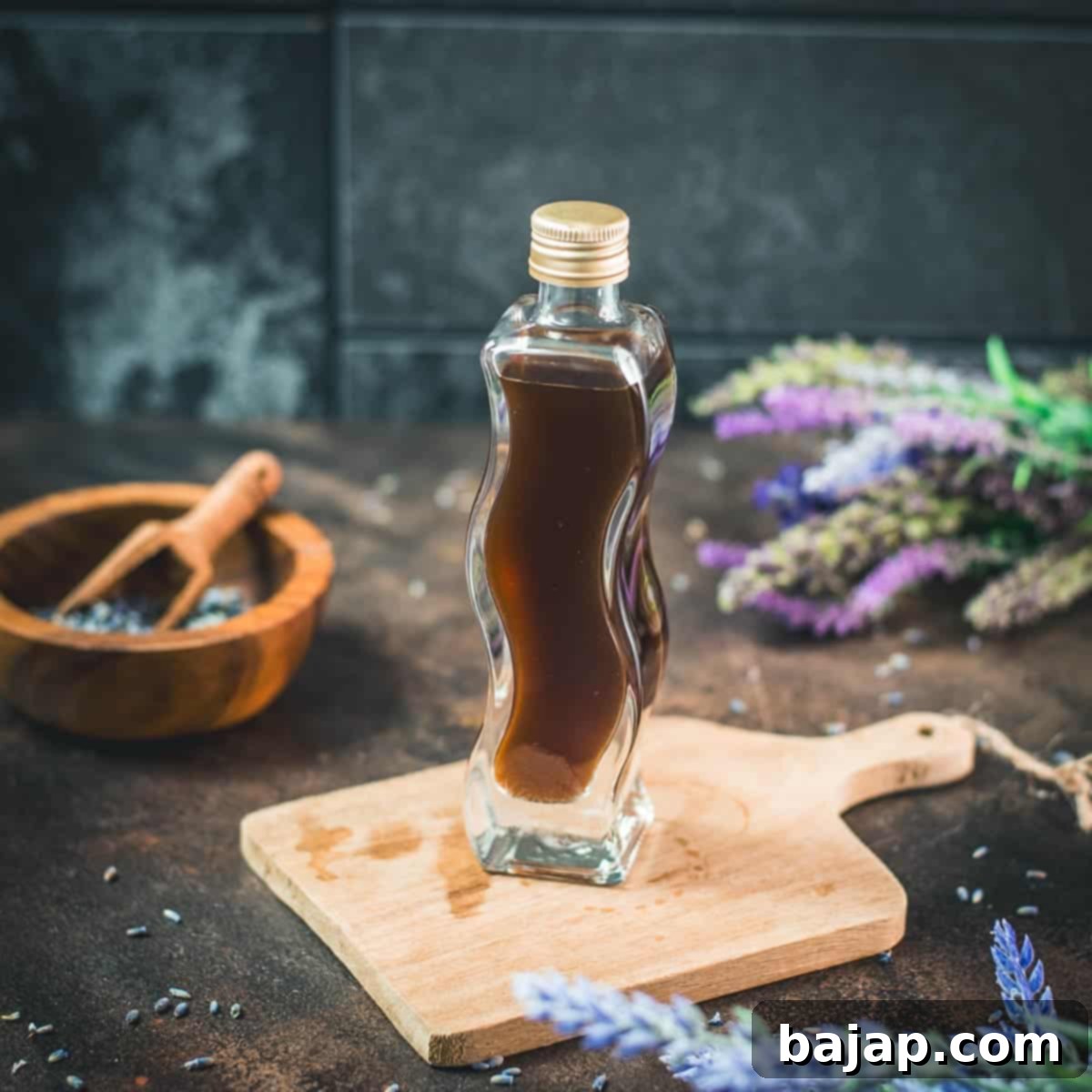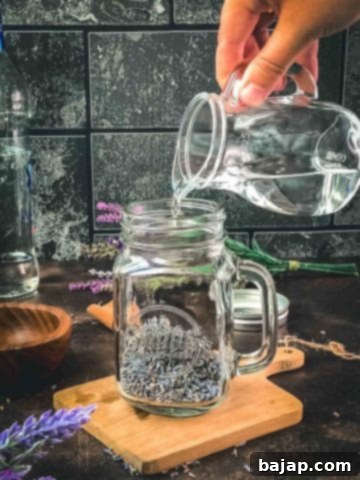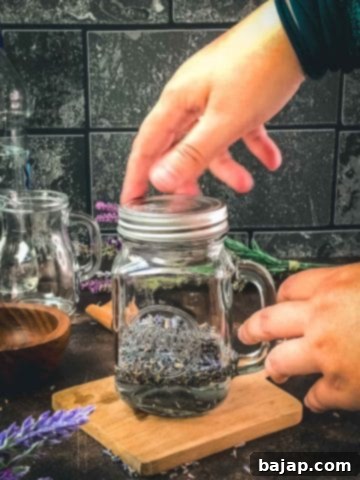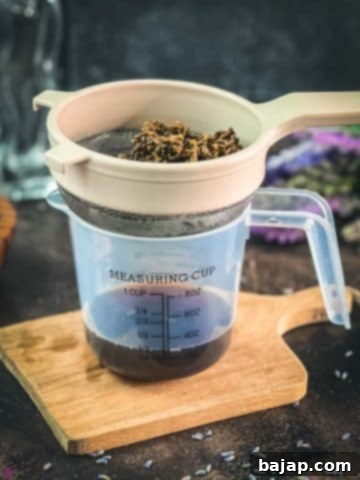Homemade Lavender Extract: A Step-by-Step Guide to Infuse Floral Magic into Your Baking
If you’re eager to truly make your lavender lemon muffins, shortbread cookies, or lemonades sing with an unparalleled depth of flavor, then crafting your own homemade lavender extract is a game-changer. The subtle, delicate, and beautifully fragrant floral notes of real lavender extract can transform ordinary recipes into extraordinary culinary experiences. Forget bland, artificial flavors – this DIY approach ensures a pure, vibrant essence that commercial extracts often lack.
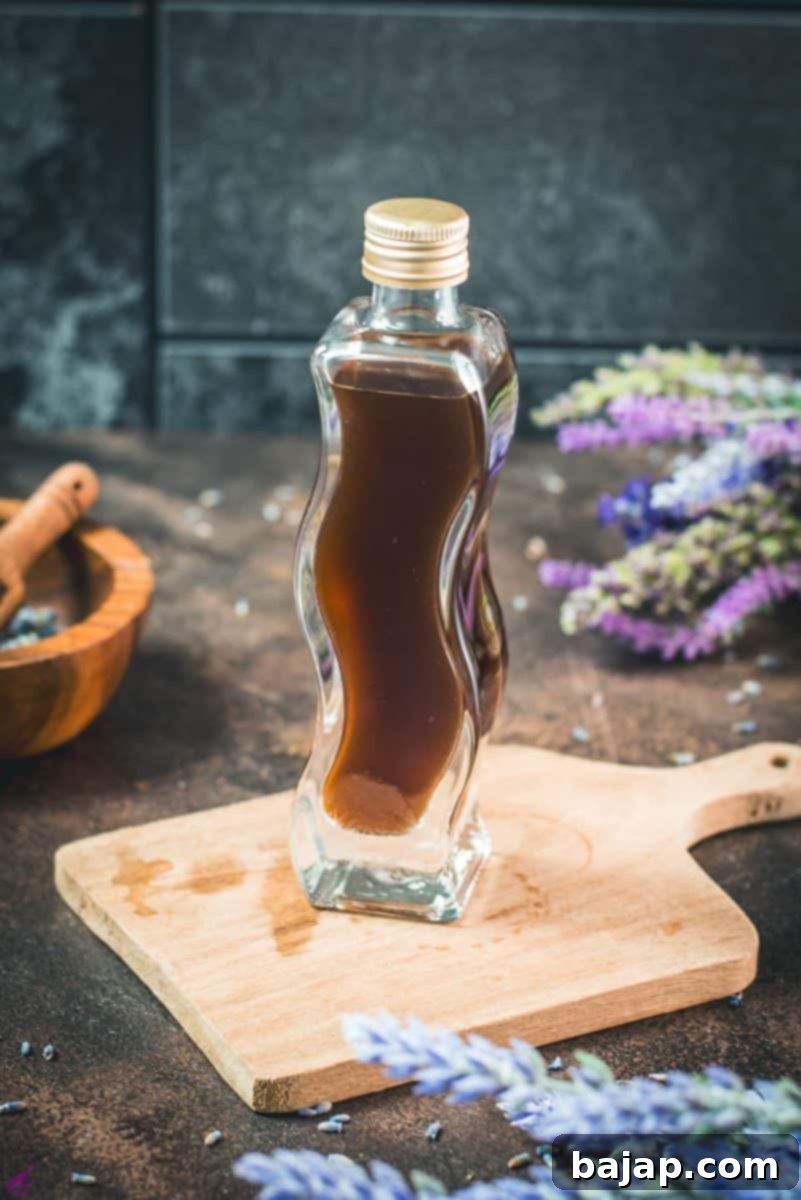
You’ll quickly fall in love with this recipe not only for its incredible, authentic lavender flavor but also for its remarkable simplicity. With just two core ingredients and a little patience, you can create a versatile extract that will become a staple in your kitchen. If you’re passionate about baking and enjoy experimenting with unique flavor profiles, this homemade lavender extract will be a repeat star in your repertoire, adding a sophisticated touch to countless dishes.
Why Make Your Own Lavender Extract?
Creating your own lavender extract offers several compelling advantages over store-bought versions. First and foremost, you gain complete control over the quality of your ingredients. This means choosing premium culinary-grade lavender and a neutral spirit, ensuring a pure and robust flavor without any unwanted additives or artificial notes. Homemade extracts often boast a more intense and nuanced flavor profile, as you can tailor the infusion time to your preferred strength.
Beyond superior taste, making your own extract is surprisingly cost-effective in the long run. While an initial investment in quality lavender might seem a bit much, a small amount goes a long way, yielding multiple batches of extract that can last for months. It’s also incredibly rewarding to use an ingredient you’ve crafted yourself, adding a personal touch to your baked goods and beverages. Furthermore, homemade lavender extract makes a thoughtful and unique gift for fellow food enthusiasts and bakers, showcasing your culinary prowess and care.
[feast_advanced_jump_to]
🥘 Ingredients for Homemade Lavender Extract
This exquisite homemade lavender extract requires only two simple ingredients. The magic truly happens through time and the quality of your chosen components.
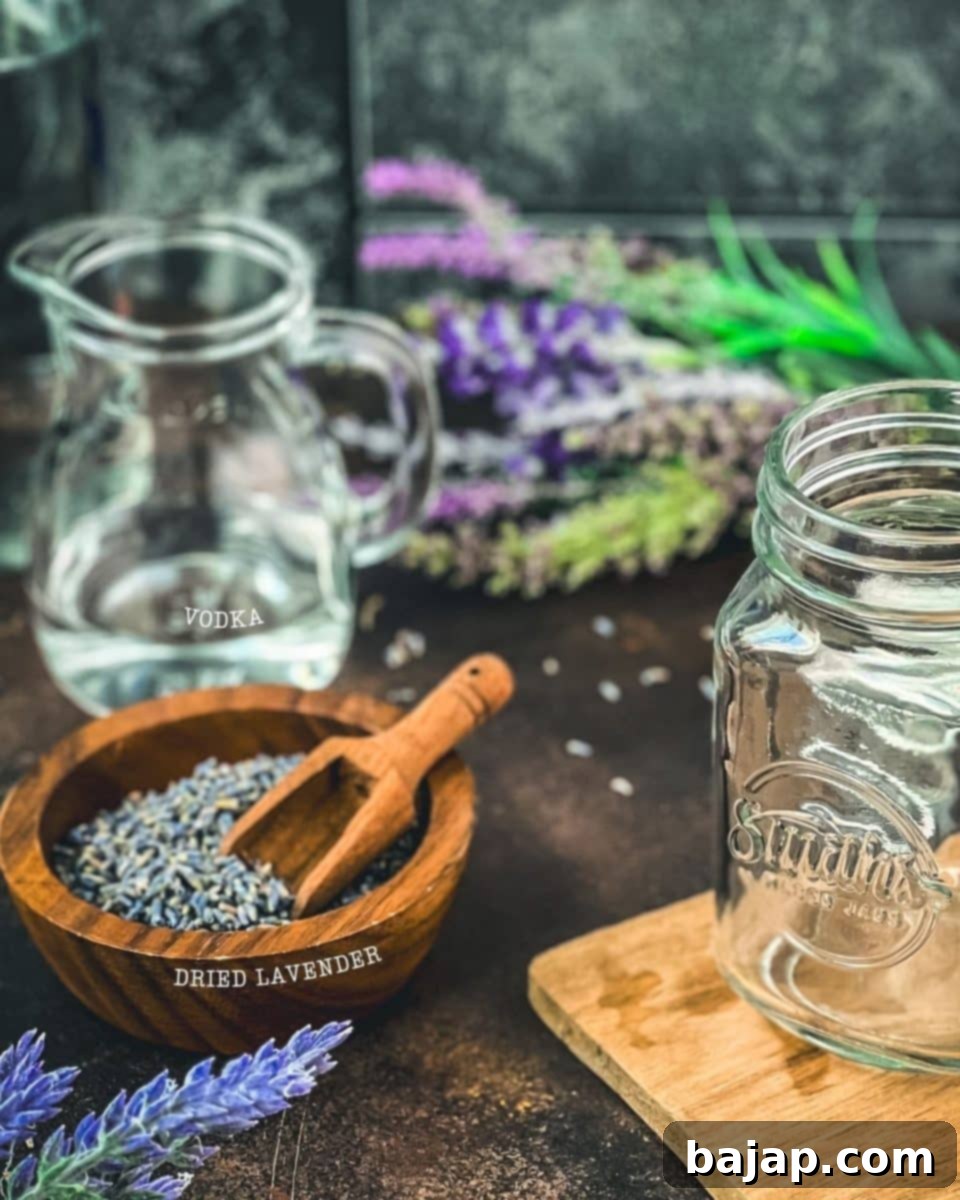
- Dried Culinary Lavender Flowers – It’s crucial to use culinary-grade lavender for any edible application. This ensures it’s free from pesticides and has the right flavor profile. You can buy it online or at specialty food stores, or use lavender you’ve grown and dried yourself.
- Vodka (or other neutral spirit) – A high-proof, neutral spirit like vodka is ideal because it effectively extracts the delicate flavors from the lavender without imparting its own strong taste. Any good quality vodka will work, but don’t feel the need to use your most expensive bottle.
For precise quantities, please refer to the detailed recipe card below.
Choosing the Right Lavender: Culinary vs. Ornamental
When it comes to making lavender extract for baking, the type of lavender you use is paramount. Not all lavender is created equal, especially when it comes to consumption. You absolutely must use culinary-grade lavender. Here’s why and how to choose it:
- Culinary Lavender: These varieties are specifically grown for their flavor and aroma, with lower camphor levels which can taste bitter or medicinal. English Lavender (Lavandula angustifolia) varieties like ‘Munstead’ or ‘Hidcote’ are excellent choices, known for their sweet, floral notes perfect for baking. They are typically lighter in color, often a true lavender-blue or purple.
- Ornamental Lavender: Varieties like Lavandin (Lavandula x intermedia), such as ‘Grosso’ or ‘Provence’, are often grown for their strong fragrance in perfumes, soaps, or dried arrangements. While beautiful, they have a much higher camphor content, which can result in a soapy or overly pungent taste when ingested. Avoid these for cooking.
If you’re using lavender from your garden, ensure it’s an English lavender variety and that it has never been treated with pesticides or herbicides. Clip sprigs when the flower buds are just opening, showing a vibrant blue-purple color, rather than faded grayish-purple ones. These contain the most concentrated oils. After clipping, you’ll need to dry them properly, as outlined in the “Storage & Tips” section.
🔪 Instructions: How to Make Lavender Extract
Making your own lavender extract is incredibly straightforward, requiring minimal effort and just a bit of patience for the infusion process. Follow these simple steps for a fragrant and potent extract:
Step 1: Combine Ingredients in a Jar
Begin by carefully measuring your dried culinary lavender flowers and pouring them into a clean, glass mason jar. Next, add the vodka to the jar, ensuring that all the lavender flowers are completely submerged beneath the liquid. This is crucial for proper extraction and to prevent any lavender from molding. Close the jar tightly with its lid, creating an airtight seal. This prevents evaporation and keeps contaminants out.
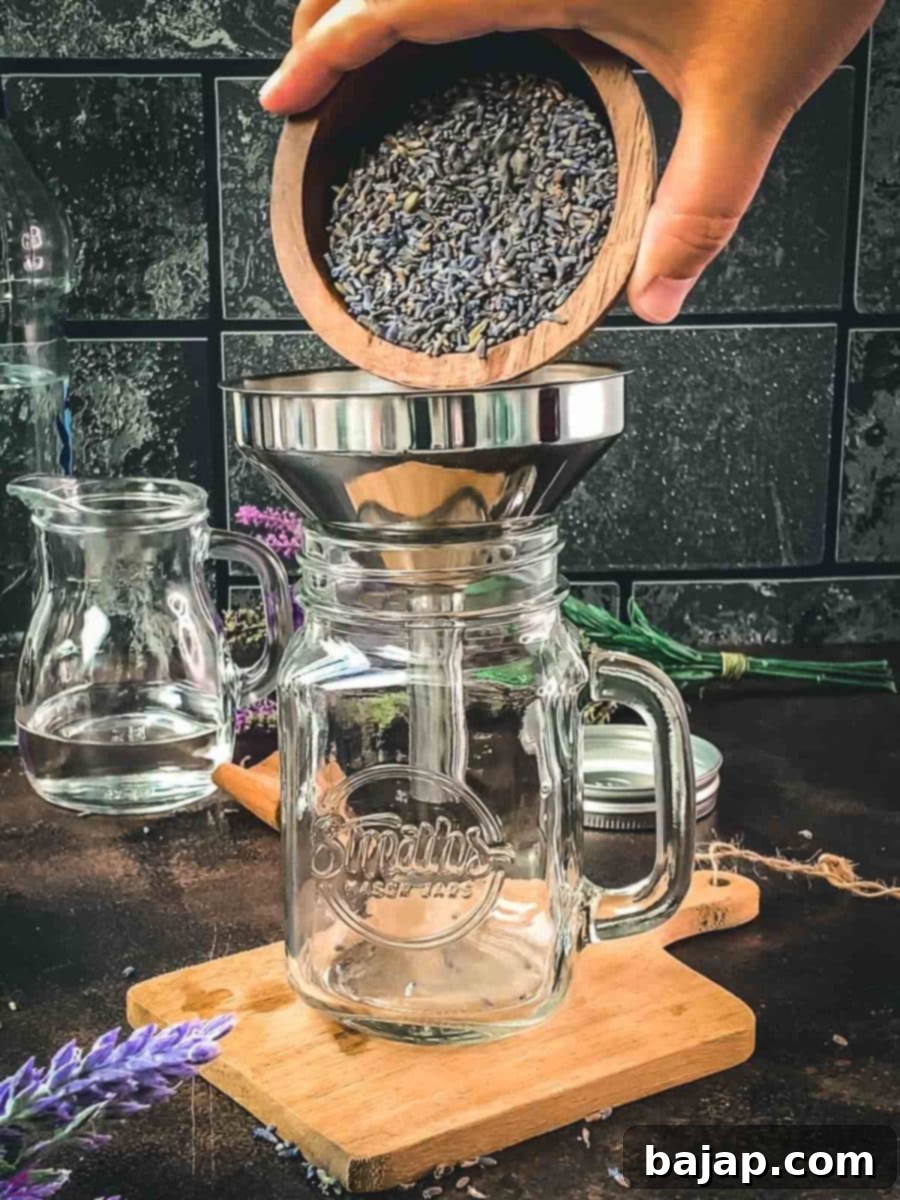
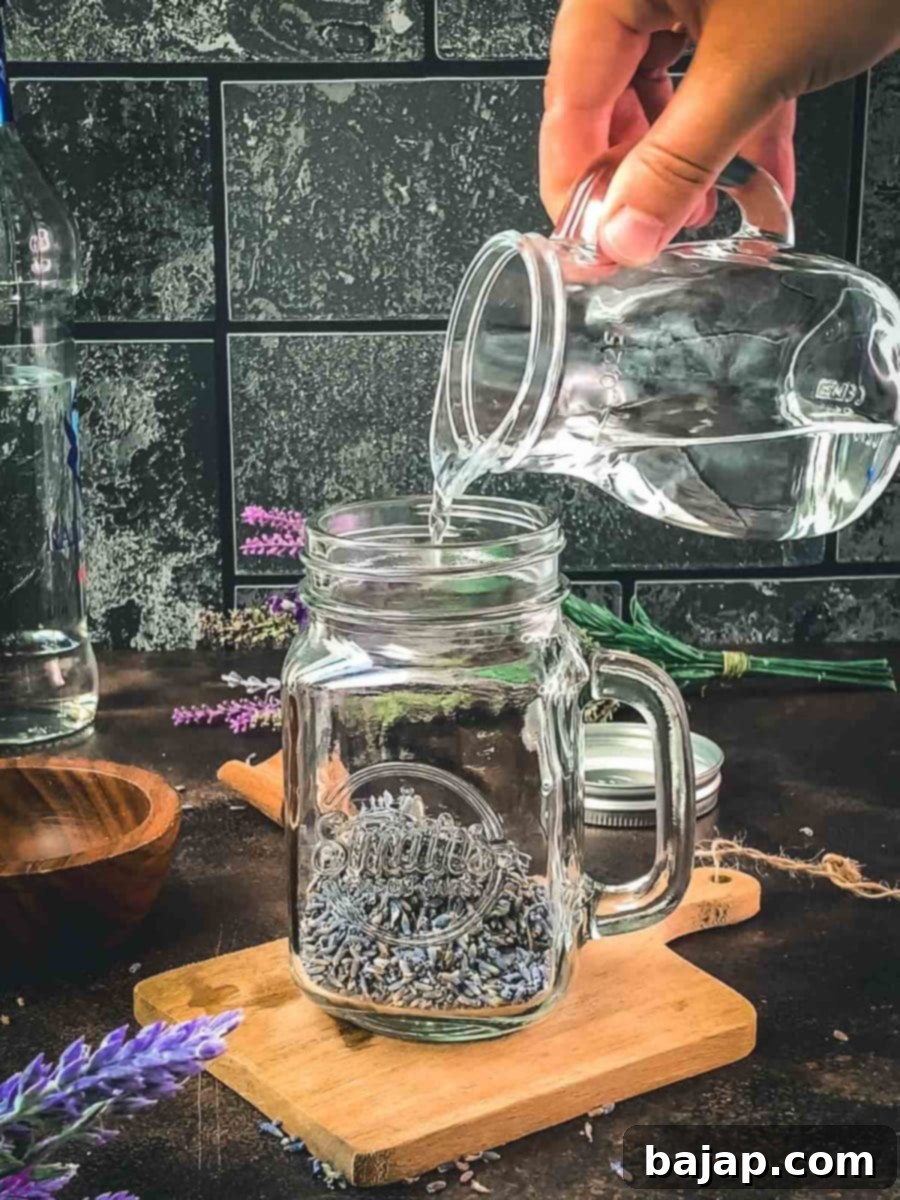
Step 2: Infusion Period & Daily Shake
Once sealed, give the jar a good shake to ensure the lavender is thoroughly mixed with the vodka. Then, store the jar in a cool, dark, and dry spot away from direct sunlight. This controlled environment is key to a slow and steady infusion, preserving the delicate aromatics of the lavender. Allow the mixture to infuse for at least one week, though two weeks is truly ideal for a more robust flavor. For an even stronger, deeper extract, you can extend this infusion period up to 4-6 weeks. Remember to shake the jar gently once daily to agitate the lavender and aid the extraction process.
Step 3: Strain the Infused Vodka
After the desired infusion period (at least two weeks for best results), it’s time to separate the liquid from the spent lavender. Open the jar and carefully strain the infused vodka through a fine-mesh sieve. For an even clearer extract, you can line the sieve with a piece of cheesecloth or a coffee filter. Once most of the liquid has drained, use the back of a spoon to gently press out any remaining liquid held within the soaked lavender flowers. This ensures you extract every last drop of precious flavor. Discard the spent lavender flowers.
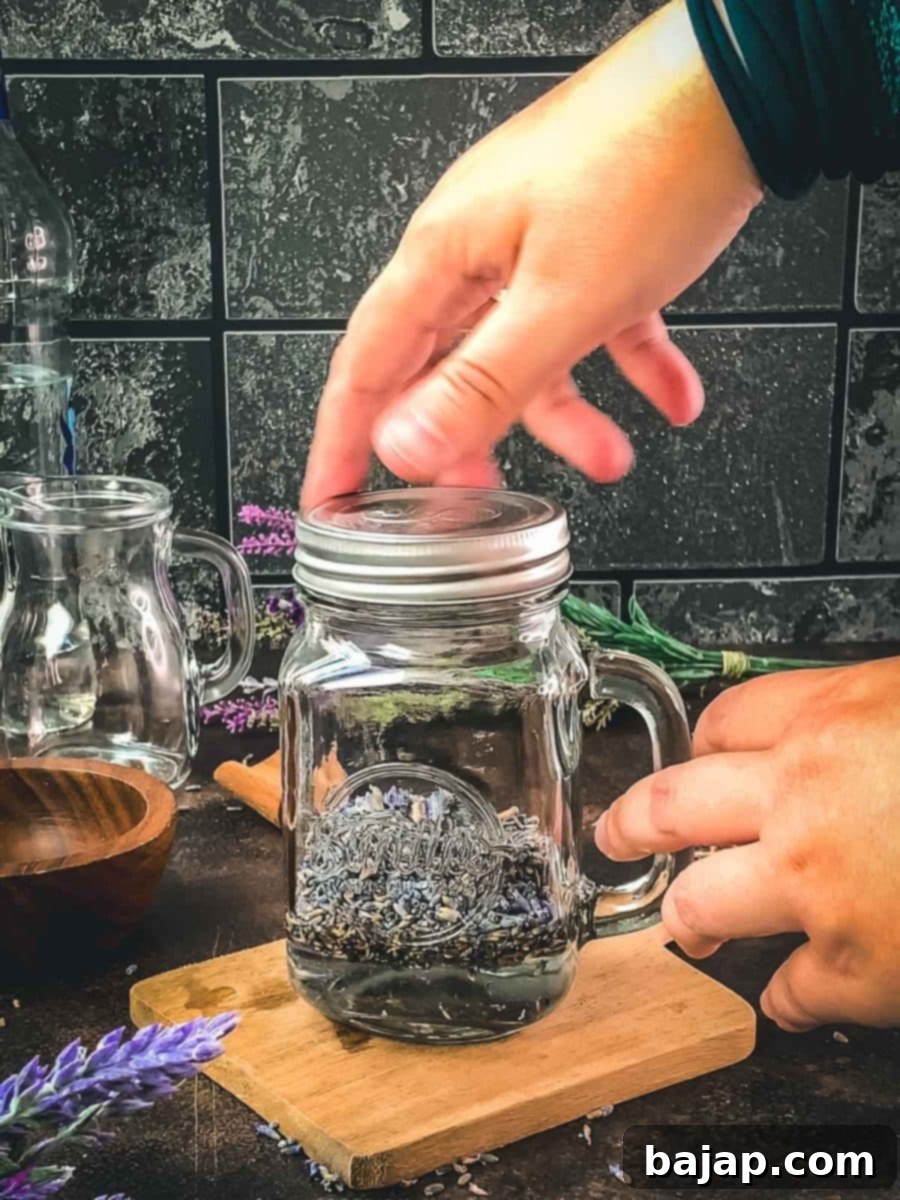
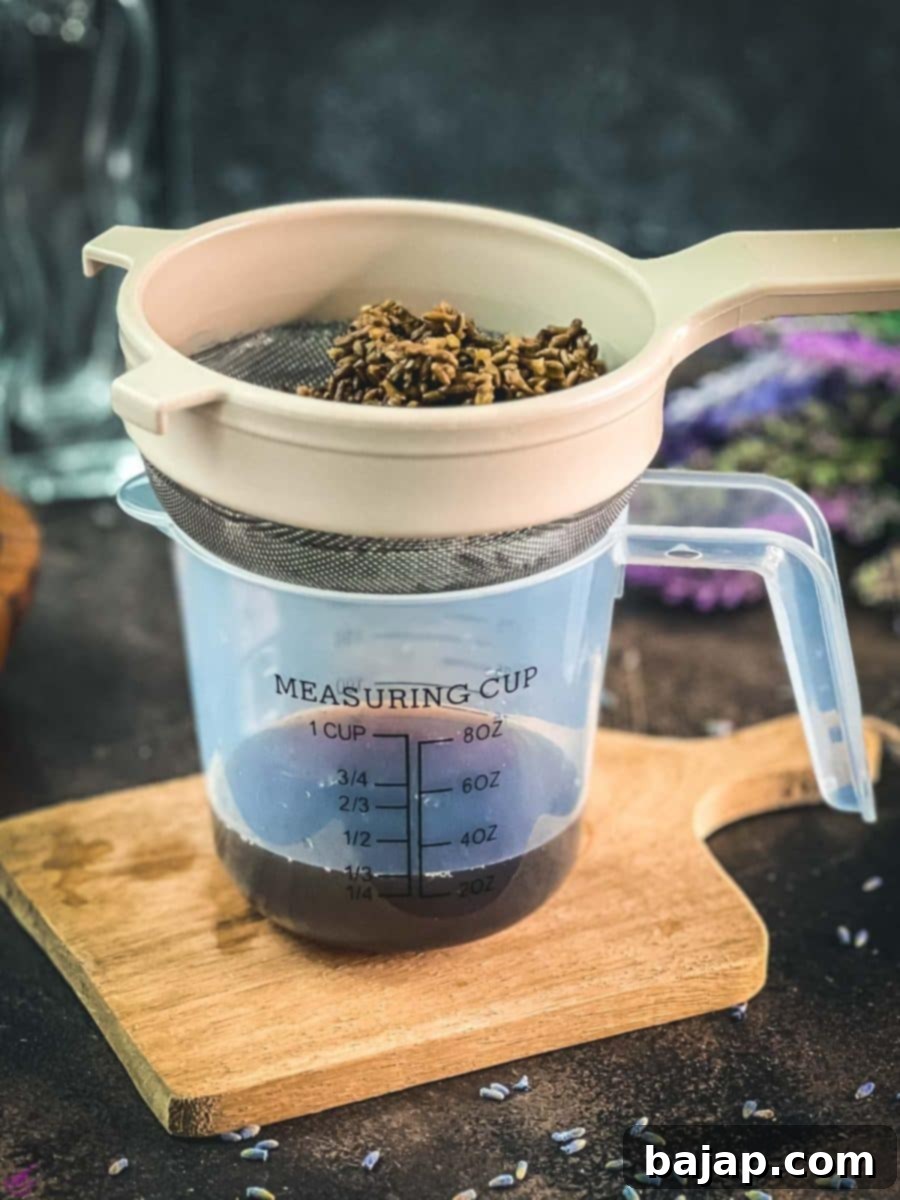
Step 4: Store Your Finished Extract
Pour your newly made homemade lavender extract into a clean, tightly closed glass bottle or jar. Dark-colored bottles are ideal as they help protect the extract from light, which can degrade its flavor and potency over time. Store it in a cool, dark pantry. Properly stored, your homemade lavender extract can last for up to a year, ready to add a burst of floral elegance to all your favorite recipes.
🍽 Essential Equipment for Making Lavender Extract
Gathering the right tools before you start ensures a smooth and successful extract-making process. Fortunately, you likely have most of these items already in your kitchen:
- Measuring Cup: Essential for accurately measuring the lavender and vodka, ensuring the correct ratio for optimal extraction.
- Mason Jar (or similar airtight glass jar): A clean, sterile glass jar with a tight-fitting lid is crucial for the infusion process. It prevents evaporation and keeps your extract fresh. The size will depend on how much extract you plan to make.
- Fine-Mesh Sieve (or strainer): Used to separate the infused vodka from the dried lavender flowers. A fine mesh ensures a clear liquid.
- (Optional) Cheesecloth or Coffee Filter: For an even clearer, sediment-free extract, line your sieve with a few layers of cheesecloth or a coffee filter during the straining step.
- (Optional) Small Glass Bottles with Airtight Lids: Perfect for storing your finished extract or for gifting. Dark-colored bottles are best for longevity.
🌡 Storage & Tips for the Best Lavender Extract
Proper storage is key to maintaining the potency and delightful flavor of your homemade lavender extract. By following these simple tips, you can enjoy your floral infusion for an extended period.
How to Store Homemade Lavender Extract
Once bottled, your homemade lavender extract can last for up to a year when stored correctly. Keep it in a tightly closed glass jar or bottle, ideally in a cool, dark pantry or cabinet, away from direct sunlight and heat. The alcohol acts as a natural preservative, but prolonged exposure to light can degrade the delicate compounds that give lavender its distinct flavor and aroma. Consider using dark-colored bottles if you plan to keep it for an extended period, or simply store clear bottles in a dark cupboard.
Sourcing and Drying Lavender for Extract
As mentioned earlier, using culinary-grade lavender is paramount. If you’re fortunate enough to have a lavender plant in your garden and plan to use fresh sprigs, ensure it’s a culinary variety (like English lavender) and free from any chemical treatments. The best time to harvest lavender for extract is when the flower buds have just opened, revealing their vibrant blue-purple color, as this is when their essential oils are at their peak.
To dry fresh lavender buds for your extract, follow these steps:
- Harvest: Cut stems just as the flowers begin to open, preferably in the morning after the dew has evaporated.
- Bundle: Gather small bundles of lavender stems and tie them together with twine or a rubber band.
- Hang: Hang the bundles upside down in a dark, warm, and well-ventilated area. Darkness helps preserve the color and essential oils.
- Dry: Allow them to dry for approximately 10 days to 2 weeks, or until the flowers are completely dry and brittle. They should easily come off the stem when gently rubbed.
- Store Dried Lavender: Once fully dried, gently remove the flowers from the stems and store them in an airtight container in a cool, dark place until ready to use for your extract.
💭 Top Tip: Patience is Key
The most crucial tip for making excellent homemade lavender extract is patience. While the recipe calls for a minimum of one week, allowing your lavender and vodka to infuse for two weeks, or even up to 4-6 weeks, will yield a significantly more potent, well-rounded, and complex flavor. The longer infusion time allows the delicate floral compounds to fully dissolve into the alcohol, creating an extract that truly sings in your baking and beverages. Don’t rush the process for the best results!
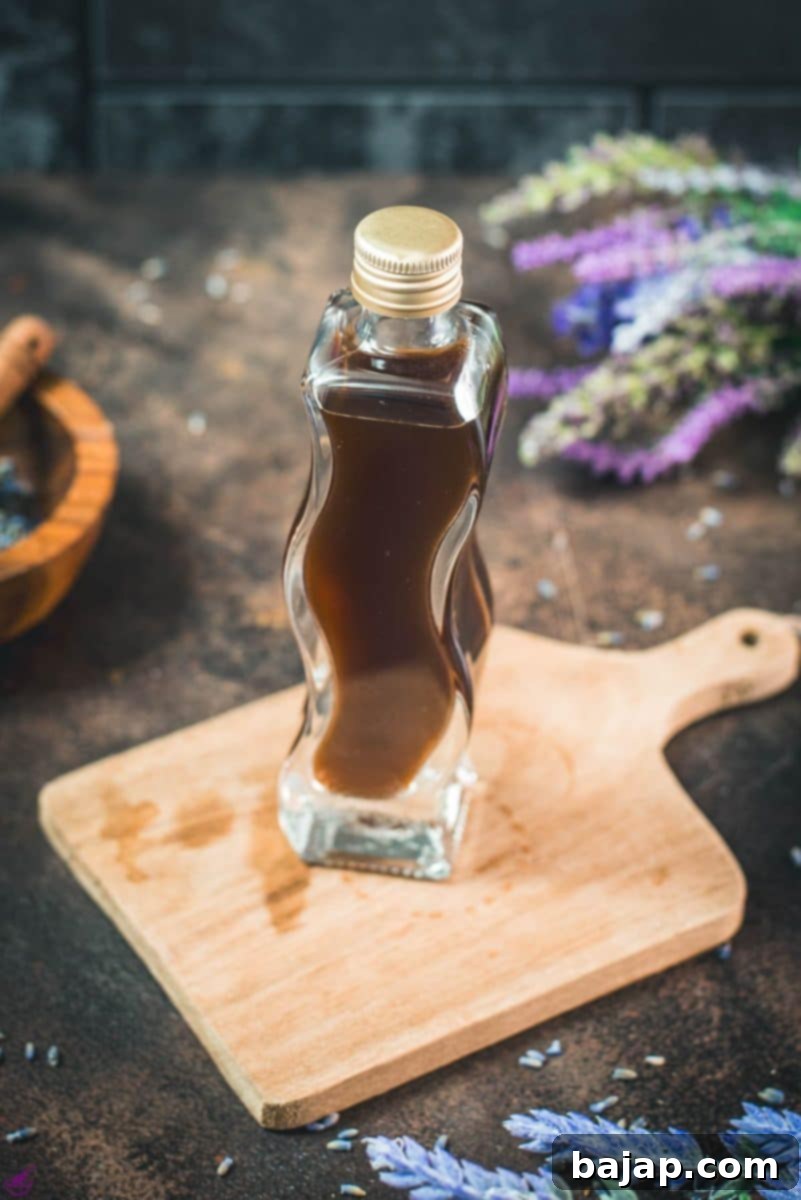
🙋🏻 Frequently Asked Questions About Lavender Extract
Lavender extract is primarily used as a flavoring agent in culinary applications. It imparts a delicate, sweet, and slightly herbaceous floral note to a wide array of dishes. Common uses include baked goods like lemon scones, cookies, cakes, and muffins, but it’s also fantastic in beverages such as cocktails (like a lavender spritz), lemonades, and teas. Don’t limit yourself to sweets; lavender extract can surprisingly complement savory dishes, glazes for roasted meats, or even fruit salads (think a tasty nectarine and peach salad). While lavender essential oils are often used aromatically for relaxation or topical skin care, culinary extract is specifically for ingestion and flavor enhancement.
Lavender extract is potent, so a little truly goes a long way! The delicate floral flavor can quickly become overpowering if too much is used, potentially turning bitter or soapy. As a general guideline, most recipes call for only about ½ teaspoon to 1 teaspoon of lavender extract for an entire batch of baked goods. When using it for the first time in a new recipe, it’s always best to start with a smaller amount (e.g., ¼ teaspoon) and then gradually add more to taste, especially if you’re sensitive to floral flavors. You can always add more, but you can’t take it away!
There are a few delightful ways to incorporate lavender into your baked goods. The most common and versatile method is using lavender extract, as detailed in this recipe. Just a few drops can infuse a subtle, even flavor throughout your dish. Another popular method is to use dried culinary lavender buds directly. These can be finely ground (often with sugar) and mixed into doughs, batters, or sugars. For example, ground lavender can be added to shortbread cookies, infused into simple syrups for drinks, or even incorporated into savory pizza dough for a surprising, aromatic twist. Lavender also pairs wonderfully with herbs like rosemary and thyme in savory applications.
For baking, the best lavender is always culinary-grade English lavender (Lavandula angustifolia) varieties such as ‘Munstead’ or ‘Hidcote’. These types have a sweeter, less camphoraceous flavor profile, meaning they won’t taste bitter or medicinal. While store-bought culinary lavender is excellent, I believe the absolute best addition to your baking recipes is a homemade extract made from lavender flowers you’ve grown and dried yourself! This gives you ultimate control over the quality and ensures freshness, resulting in the most vibrant and authentic lavender flavor.
Primarily, homemade lavender extract provides a unique and delicious floral flavor and aroma to dishes. It elevates baked goods like lavender lemon bars, adds depth to frostings, and brings an aromatic sophistication to beverages. Beyond its delicious culinary contributions, some people associate lavender with potential calming properties, though it’s important to distinguish that culinary extract (which contains very dilute compounds) is not the same as concentrated lavender essential oil used in aromatherapy or topical applications. For culinary purposes, its main function is to infuse a delightful, fragrant dimension into your food.
More Delightful Lavender Recipes & Related Infusions
Once you’ve mastered homemade lavender extract, a world of floral-infused culinary creations opens up! Here are some other recipes, both existing and upcoming, that will allow you to explore the versatility of this beautiful herb:
- Lavender Extract (Current Recipe) – Master the base first!
- Lovely Lavender Spritz Cocktail – A refreshing drink perfect for a warm evening.
- Lavender Daiquiri – A sophisticated twist on a classic cocktail.
- Lavender Spritz with Prosecco (coming soon) – Elevate your spritz game with some bubbly.
- Lavender Sugar (coming soon) – An easy way to infuse sugar for baking and beverages.
- Lavender
Gin and Tonic (coming soon) – A fragrant upgrade to your favorite G&T. - Lavender Lemon Muffins (coming soon) – The perfect application for your homemade extract.
- Lavender Cookies (coming soon) – Delicate and aromatic treats.
- Lavender Liqueur (coming soon) – For those who want to take their lavender infusions to the next level.
- Homemade Vanilla Extract – If you enjoyed this, you’ll love making other extracts too!
- Candied Violets – Explore other floral delights in your baking.
If you make this recipe for homemade lavender extract, please let me know how you liked it by giving it a ★★★★★ star rating and leaving a comment below. Your feedback is incredibly valuable and helps other home bakers discover this wonderful recipe! You can also sign up for our Newsletter to receive weekly delicious homemade recipes directly to your inbox. Don’t forget to follow me on Pinterest or Instagram and share your beautiful creations with me. Just tag me @combinegoodflavors and use the hashtag #combinegoodflavors, so I don’t miss it!
📖 Recipe: Homemade Lavender Extract for Baking
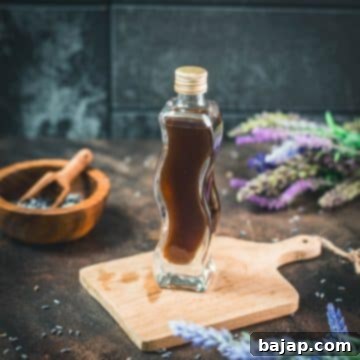
Homemade Lavender Extract for Baking
Nora
Save RecipeSaved!
Pin Recipe
Equipment
-
Measuring cup
-
Mason Jar
-
Sieve
Ingredients
- 2 tablespoon Dried culinary lavender flowers
- 2.7 oz Vodka (or other neutral spirit)
Instructions
-
In a clean, glass mason jar, combine 2.7 oz Vodka with 2 tablespoon Dried culinary lavender flowers. Ensure the lavender is fully submerged in the vodka.2 tablespoon Dried lavender, 2.7 oz Vodka

-
Seal the jar tightly and give it a good shake. Store the jar in a cool, dark, and dry spot away from direct sunlight. Allow it to infuse for at least one week, but for optimal flavor, aim for two weeks. Remember to shake the jar gently once daily to aid the infusion process.

-
After the infusion period, the vodka should be deeply fragrant. Strain the infused vodka through a fine-mesh sieve (and optionally, a cheesecloth-lined sieve for extra clarity). Press out any liquid held in the lavender before discarding the solids.

-
Pour the finished lavender extract into a clean, tightly closed glass bottle or jar. Store it in a cool, dark pantry to maintain its potency and flavor for up to a year.
Nutrition values are estimates only, using online calculators. Please verify using your own data.

🤎 You Might Also Like These Recipes
If you enjoyed making this homemade lavender extract, you’ll love exploring other ways to infuse flavors and create unique culinary delights. Here are some related recipes to inspire your next kitchen adventure:
- Sweet & Smooth: The Best Vanilla Vodkas to Try
- How to make Candied Violets
- Three Ways to make Vanilla Sugar at Home
- Lovely Lavender Spritz Cocktail
⛑️ Food Safety Guidelines for Extracts
While making extracts generally involves alcohol which acts as a preservative, it’s always wise to keep food safety in mind, especially when handling ingredients for consumption. This recipe does not involve cooking, but good hygiene is always recommended:
- Always use clean and sterilized glass jars and equipment to prevent contamination.
- Ensure your culinary lavender is free from pesticides and thoroughly dried.
- Store the finished extract in a cool, dark place to maintain quality and prevent degradation over its long shelf life.
- Though unrelated to this specific recipe, general food safety practices include cooking to minimum temperatures, avoiding cross-contamination, and proper storage of all food items.
For comprehensive food safety information, always check reputable sources such as Safe Food Handling – FDA.
